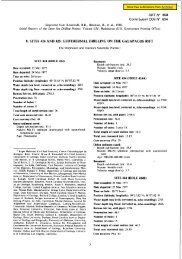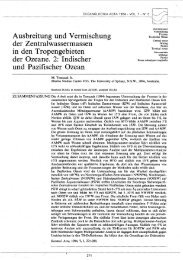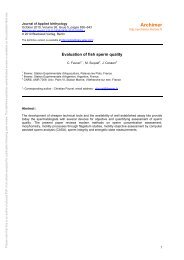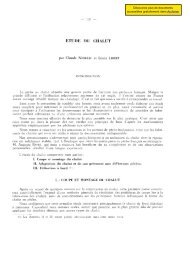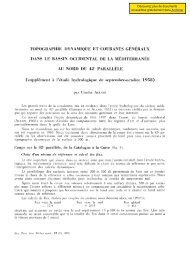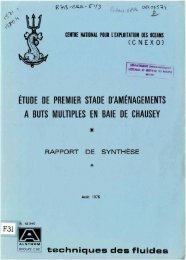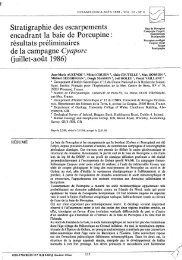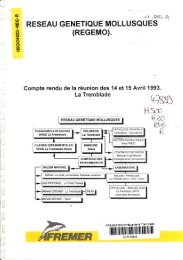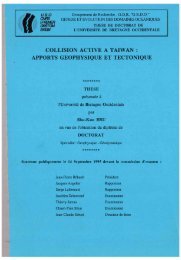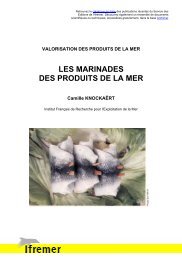Approche quantitative de la fonction de nourricerie jouée par les ...
Approche quantitative de la fonction de nourricerie jouée par les ...
Approche quantitative de la fonction de nourricerie jouée par les ...
You also want an ePaper? Increase the reach of your titles
YUMPU automatically turns print PDFs into web optimized ePapers that Google loves.
Chapitre 4 : Impact of vegetation structure dynamics and usage on the nursery function of<br />
West European tidal salt-marshes.<br />
5.1. The Aiguillon bay and the Mont Saint-Michel bay, two mo<strong>de</strong>ls of<br />
nurseries :<br />
The fish popu<strong>la</strong>tion sampled in the Aiguillon bay was broadly simi<strong>la</strong>r in its structure to<br />
that <strong>de</strong>scribed in the salt marshes on the west coats of France (Laffaille 2000; Duhamel et al.<br />
2002; Parlier 2002). Twenty five species were recor<strong>de</strong>d in the Aiguillon bay. A previous<br />
study conducted in the Aiguillon bay mentioned 15 species (Gascuel et Legault 1989),<br />
including migratory species (Petromyzon marinus, Alosa alosa, Salmo trutta), but this was<br />
not conducted in the same conditions as it was a study of the trash fish discards from the nets<br />
of elver fishermen further upstream in the estuary of the Sèvre Niortaise river.<br />
The popu<strong>la</strong>tion of the Aiguillon bay is dominated in terms of biomass by the species<br />
<strong>de</strong>tritivorous feeding species (Mugilidae) that account for up to 96% of the biomass captured,<br />
as is often the case in this type of coastal area (Feunteun et al. 1999; Laffaille et al. 2000a).<br />
Gol<strong>de</strong>n grey mullet, Thinlip mullet and Common goby are the most frequent species with<br />
frequency of occurrence values of 92.6%, 77.8% and 85.2%, respectively. These three species<br />
enter the salt marshes for feeding. The <strong>de</strong>tritivorous species characteristic of intertidal<br />
mudf<strong>la</strong>ts take advantage of the high production of benthic micro-algae on the mudf<strong>la</strong>ts<br />
adjoining the salt marshes (Laffaille et al. 1998; Almeida 2003). Common goby and Sand<br />
goby conduct the whole of their life cycle in these intertidal zones and consume the prey<br />
occurring in the marsh when it is submerged (Laffaille et al. 1999; Parlier 2002). The high<br />
numbers of Seabass (5464), Clupeidae yoy (960), European sprat (515) and European<br />
anchovy (1063) composed almost exclusively of juveni<strong>les</strong> <strong>de</strong>monstrates the nursery function<br />
of these ecosystems, even if it is preferable to rely on more criteria to <strong>de</strong>scribe this function<br />
(Beck et al. 2001), such as use of the biomass produced in situ, or the migration towards the<br />
sites frequented at the adult stage. The colonisation of salt marshes is the result of a passive<br />
transport of the <strong>la</strong>rvae (Dame et Allen 1996), undoubtedly from adjacent creeks and channels.<br />
These areas therefore p<strong>la</strong>y a fundamental role in the growth and survival of young fish by<br />
providing them with the trophic resources that contribute up to 50 to 90% of the growth of<br />
young Seabass (Laffaille et al. 2001b). The patterns of salt marsh colonisation are simi<strong>la</strong>r to<br />
those <strong>de</strong>scribed in Mont Saint-Michel bay, where three periods were <strong>de</strong>scribed (Laffaille et al.<br />
2000a). The spring period (April to June) had a lower abundance in terms of numbers and<br />
biomass than in the Aiguillon bay. This difference could be due to the more northerly location<br />
of this <strong>la</strong>rge bay, where temperature conditions may be <strong>les</strong>s favourable.<br />
138



